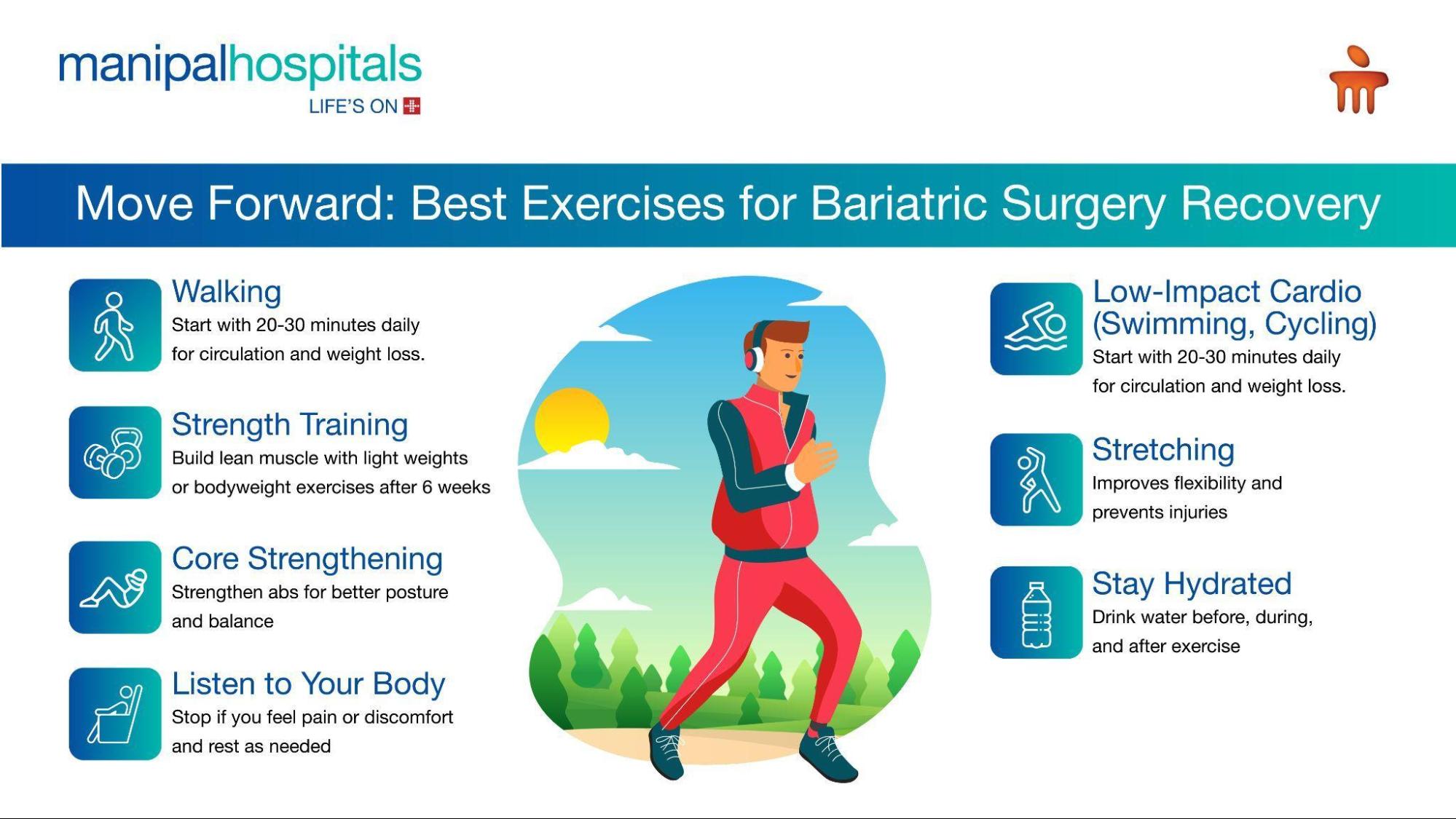
Congratulations on taking a life-changing step toward better health with bariatric surgery! This new chapter is an exciting opportunity for transformation, and incorporating the right exercise post-bariatric surgery is a crucial part of maximising your results and maintaining your newfound energy. As you begin your journey, you might be wondering: Where do you start, and what are the best exercises for bariatric patients? Don’t worry—this guide is here to help you navigate the world of bariatric exercises, with practical tips for each stage of your recovery.
Whether you're just beginning your exercise routine or looking to challenge yourself with more advanced movements, this guide will provide the insights, motivation, and tips you need to make exercise after gastric sleeve surgery an exciting and rewarding part of your lifestyle.
Synopsis
How Soon Can You Start Exercising After Bariatric Surgery?
After bariatric surgery, your body will need some time to heal, so it's important to take a gradual approach to exercise. Most patients can begin light activities, such as short walks, just a few days after surgery. Walking is an excellent way to improve circulation, reduce the risk of blood clots, and support your recovery.
As your recovery progresses, you can gradually introduce bariatric exercises into your routine. Typically, you’ll be able to start low-impact cardio exercises like moderate-paced walking or gentle swimming 2 to 4 weeks after surgery. However, strength training and higher-intensity activities should be postponed until around 6 weeks, or when your healthcare provider gives you the green light.
Best Exercises for Bariatric Patients Post-Surgery
Incorporating the right exercise into your post-surgery routine is vital for boosting weight loss, maintaining muscle mass, and improving overall well-being.

Below is a guide to the best exercise for bariatric patients at different stages of recovery:
1. Early Post-Operative Phase (Weeks 1-4): Gentle Movements
In the first few weeks after surgery, your body needs time to adjust. During this phase, focus on gentle, low-impact activities to support your healing while avoiding any strain.
-
Walking: Start with short, easy walks around your home or hospital. Gradually increase the duration as you feel more comfortable. Aim for 10-15 minutes, two to three times a day.
-
Deep Breathing Exercises: These exercises will help improve your lung capacity and circulation, which are essential for recovery.
-
Light Stretching: Gentle stretches can maintain flexibility and prevent stiffness. Avoid any movements that might strain your abdominal muscles.
2. Intermediate Phase (Weeks 4-6): Low-Impact Cardio
As your body heals, you can begin incorporating more structured, low-impact cardiovascular exercises post-bariatric surgery. These exercises are great for improving your cardiovascular health and supporting your weight loss efforts.
-
Walking: Continue to increase the intensity and duration of your walks. Aim for 30 minutes, five days a week.
-
Swimming: Once your incisions have fully healed, swimming is an excellent exercise after gastric sleeve surgery. It engages multiple muscle groups while providing a low-impact workout that is gentle on the body.
-
Cycling: Stationary biking is another great low-impact exercise. It helps elevate your heart rate without stressing your joints, making it perfect for the weeks following surgery.
3. Strength Training (Week 6 and Beyond): Building Muscle Mass
After the initial recovery phase, it’s important to incorporate strength training to prevent muscle loss and boost your metabolism. Focus on light, controlled movements and gradually build up intensity.
-
Bodyweight Exercises: Start with basic bodyweight exercises like squats, lunges, and modified push-ups. These exercises will help you build strength without requiring any equipment.
-
Resistance Bands: These are great for adding resistance while keeping the movements gentle. Seated rows, bicep curls, and lateral raises are great exercises to do with bands.
-
Weight Training: Once you're comfortable, you can start using light weights. Focus on major muscle groups with exercises like chest presses, leg presses, and shoulder presses. Always use proper form to avoid injury.
4. Long-Term Maintenance: Varied and Enjoyable Activities
Once you've gained strength and endurance, it’s time to add variety to your routine to keep things exciting and sustainable.
-
Aerobic Exercises: Activities like brisk walking, jogging, dancing, or using an elliptical machine are excellent for maintaining cardiovascular health and supporting weight management.
-
Yoga and Pilates: These practices are not only great for improving flexibility and core strength but also help reduce stress and enhance mental well-being.
-
Group Classes: Joining fitness classes like Zumba, spinning, or even a local walking group can provide extra motivation, accountability, and a sense of community.
Benefits of Exercise After Bariatric Surgery
Regular exercise plays a crucial role in optimising your bariatric surgery results and improving your overall quality of life. Here are the top benefits of staying active post-surgery:
-
Weight Loss and Maintenance: Exercise helps burn calories, maintain muscle mass, and boost metabolism, making it essential for sustained weight loss.
-
Cardiovascular Health: Physical activity improves heart health by lowering blood pressure and cholesterol levels.
-
Mental Health: Exercise helps combat stress, anxiety, and depression by increasing endorphins and improving body image.
-
Musculoskeletal Health: Strengthening bones and muscles reduces the risk of osteoporosis and joint pain while improving posture.
-
Metabolic Rate: Regular activity boosts metabolism and enhances fat burning, helping you maintain your weight loss.
-
Better Sleep: Exercise improves sleep quality and reduces the severity of sleep apnoea.
-
Increased Energy: Staying active helps increase stamina and combat fatigue, making everyday tasks easier.
-
Long-Term Health: Regular exercise contributes to a longer lifespan by reducing the risk of chronic conditions like heart disease and diabetes.
Safety Tips for Exercising After Bariatric Surgery
While exercise is essential for recovery and long-term success, it’s important to stay safe. Follow these tips to ensure you’re exercising in a healthy, sustainable way:
-
Consult Your Healthcare Provider: Always seek approval before starting a new exercise routine. Your doctor will provide personalised guidance based on your recovery.
-
Start Slow and Gradually Increase Intensity: Begin with gentle movements and increase the duration and intensity as your body adjusts.
-
Focus on Low-Impact Exercises: In the early stages, opt for low-impact exercises like walking, swimming, or cycling to reduce strain on your body.
-
Listen to Your Body: If you experience pain, dizziness, or fatigue, stop and rest.
-
Warm-Up and Cool-Down: Proper warm-ups and cool-downs are essential for preventing injury and improving flexibility.
-
Stay Hydrated: Drink plenty of water to avoid dehydration and maintain energy levels.
-
Use Proper Technique: Pay attention to your form to prevent injuries. Working with a trainer experienced with post-bariatric surgery patients is a great option.
-
Wear Proper Footwear: Supportive shoes are crucial for reducing the risk of injury.
-
Monitor Your Progress: Keep track of your improvements and adjust your routine as you get stronger.
-
Avoid Heavy Lifting Early On: Start with light weights and avoid heavy lifting until you’re fully healed.
-
Seek Help When Needed: If you experience unusual symptoms, consult your bariatric surgeon immediately.
FAQ's
You can start with light walking and gentle movements as soon as you feel comfortable, usually around 1-2 weeks after surgery. Gradually increase intensity based on your recovery and doctor’s advice.
Low-impact exercises like walking, swimming, and cycling are ideal during the initial recovery stages. Strength training with light weights and bodyweight exercises can be introduced after 6 weeks.
Aim for at least 30 minutes of moderate exercise most days of the week, gradually increasing duration and intensity as your body adapts.
Yes, regular exercise boosts metabolism, burns calories and helps maintain muscle mass, making it crucial for long-term weight maintenance.
Start slow, listen to your body, stay hydrated, focus on proper form, and avoid heavy lifting until you’re fully healed. Always consult your healthcare provider before starting or adjusting your exercise routine.





















 7 Min Read
7 Min Read











